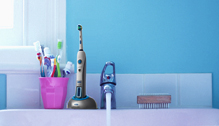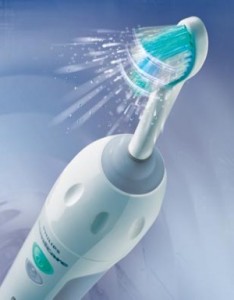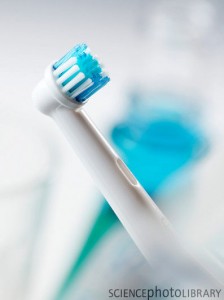In most developed countries, the number of powered or electric toothbrush products sold has increased dramatically in recent years. An electric toothbrush is a toothbrush usually powered by a battery to move the brush head. Most modern electric toothbrushes have a small, circular head which performs oscillating (having periodic vibrations), rotating or counter-rotational movements. Some models have timers which give useful feedback to the user on the time spent on brushing.
History of electric toothbrushes
In the beginning of the 1960s the first usable electric toothbrush, Broxodent, was introduced by Dr. Philippe-Guy Woog in Switzerland. With the commercial success of this product, battery-powered products were introduced with the advantage of being portable and available at a lower cost. Unfortunately, problems with these battery-powered products included short “working times” and mechanical breakdowns. The enthusiasm for the powered toothbrush declined and was recommended mainly for the handicapped.
In the 1980s, the category of powered toothbrushes was revitalized with the introduction of the InterPlak product. This “second generation” powered toothbrush had a uniquely rotating head and was powered by long-life/ rechargeable batteries.
Since then, sonic-powered toothbrushes of a “third” generation have been developed and shown to remove more plaque in comparison to manual toothbrushes, especially in long-term studies. Two primary types of head designs are now used: the rotating, oscillating type with a small, round molar-crown-size brush head and three oscillating brushes with either vibrating or rotational sonic movements.
Most recently, electric toothbrushes have been introduced that are battery-powered or disposable after “running down,” and are priced, in the United States below $20.00.
Types of electric toothbrushes
Electric toothbrushes can be battery-operated or rechargeable, with the former a cheaper option on-the-shelf. Rechargeable electric toothbrushes tend to have a higher price value than battery-powered and regular manual toothbrushes. Regular manual toothbrushes cost the least, and they are often sold in multi-packs as well as individually. Battery-powered toothbrushes are usually only a few dollars more than ordinary manual toothbrushes, however do remember to factor in the cost of batteries you may need.
The two main types of powered toothbrushes, which can be either battery-charged or rechargeable, are:
Rotary electric toothbrushes
The bristles of these brushes move in an oscillating or pulsating motion at a frequency of 3,000-7,500 brush strokes per minute. They have either a circular arrangement of bristles or they are arranged as in a manual toothbrush. The cleaning action of these toothbrushes is primarily by scrubbing the teeth when oscillating bristles come in contact with the teeth. They can have oscillating or spinning motions.
Sonic toothbrushes
Generating 30,000-40,000 strokes per minute, these toothbrushes are based on more advanced technology than rotary toothbrushes. They work on the principle of oscillating motion as well as “acoustic streaming action†for removal of plaque on teeth.
Special uses for electric toothbrushes
 Electric toothbrushes can be beneficial for parental brushing of children’s teeth; for children and adults who are physically handicapped, mentally retarded, aged, arthritic, or otherwise with poor dexterity; and for those individuals who are poorly motivated in keeping their oral hygiene. These toothbrushes are especially recommended for individuals who require a larger handle, because powered models are easier to grasp.
Electric toothbrushes can be beneficial for parental brushing of children’s teeth; for children and adults who are physically handicapped, mentally retarded, aged, arthritic, or otherwise with poor dexterity; and for those individuals who are poorly motivated in keeping their oral hygiene. These toothbrushes are especially recommended for individuals who require a larger handle, because powered models are easier to grasp.
Do electric toothbrushes really work better than regular ones?
Recent research by the Cochrane Collaboration, an independent non-profit organization which evaluates medical practices, finds that regular toothbrushes work as well as most electric toothbrushes – assuming that individual who uses the manual toothbrushes brushes efficiently.
The rotary/oscillation powered toothbrushes were shown to work slightly better at cleaning teeth than manual toothbrushes. The research concludes that the way of brushing is more important than the choice of brush.
Replacing electric toothbrushes
The effectiveness of an electric toothbrush depends not only on its type of action and on correct use, but also on the condition of the brush head. Toothbrush wear (splayed, bent, or broken bristles) is influenced more by brushing methods than by the length of time or number of brushings per day. The heads of most powered or mechanical toothbrushes are smaller than manual toothbrushes and are usually removable to allow for replacement.
Most manufacturers, as well as dental professionals, recommend that electric toothbrush heads be changed every three to six months at minimum, or as soon as the brush head has visibly deteriorated. If toothbrushes need to be replaced more frequently than every three months, the individual’s brushing technique should be checked. Even if the brushing technique is acceptable or has been corrected, toothbrushes should still be replaced frequently. Indeed, after every contagious medical illness or mouth infections, it is necessary that individuals be made aware of the importance of having a new toothbrush.


